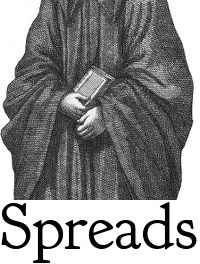Plugins¶
spreads comes with a variety of plugins pre-installed. Plugins perform their actions at several designated points in the workflow. They can also add specify options that can be set from one of the interfaces.
subcommand plugins¶
These plugins add additional commands to the spread application. This way, plugins can implement additional workflow steps or provide alternative interfaces for the application.
gui¶
Launches a graphical interface to the workflow. The steps are the same as with the CLI wizard, additionally a small thumbnail of every captured image is shown during the capture process. Requires an installation of the PySide packages. Refer to the GUI tutorial for more information.
postprocess plugins¶
An extension to the postprocess command. Performs one or more actions that either modify the captured images or generate a different output.
autorotate¶
Automatically rotates the images according to their device of origin. By default this means -90° for odd pages and 90° for even pages, but these can be set to arbitrary values by specifying the rotate-even or rotate-odd options. You probably want to stick to multiples of 90°.
- --rotate-even¶
Change rotation for images from even book pages (default: 90°)
- --rotate-odd¶
See above, only for odd pages (default: -90°)
colorcorrect¶
Automatically fixes white balance for your scanned images. To use it, enable it in the configuration, set the RGB values for your grey cards and ensure that the first two images you take are of your grey cards.
scantailor¶
Automatically generate a ScanTailor configuration file for your scanned book and generate output images from it. After the configuration has been generated, you can adjust it in the ScanTailor UI, that will be opened automatically, unless you specified the auto option. The generation of the output images will run on all CPU cores in parallel.
- --autopilot¶
Run ScanTailor on on autopilot and do not require and user input during postprocessing. This skips the step where you can manually adjust the ScanTailor configuration.
- --detection <content/page> [default: content]¶
By default, ScanTailor will use content boundaries to determine what to include in its output. With this option, you can tell it to use the page boundaries instead.
- --no-content¶
Disable content detection step.
- --rotate¶
Enable rotation step.
- --no-deskew¶
Do not deskew images.
- --no-split-pages¶
Do not split pages.
- --no-auto-margins¶
Disable automatically detect margins.
tesseract¶
Perform optical character recognition on the scanned pages, using the tesseract application, that has to be installed in order for the plugin to work. For every recognized page, a HTML document in hOCR format will be written to project-directory/done. These files can be used by the output plugins to include the recognized text.
- --language LANGUAGE¶
Tell tesseract which language to use for OCR. You can get a list of all installed languages on your system by running spread capture –help.
output plugins¶
An extension to the out command. Generates one or more output files from the scanned and postprocessed images. Writes its output to project-directory/done.
pdfbeads¶
Generate a PDF file from the scanned and postprocessed images, using the pdfbeads tool. If OCR has been performed before, the PDF will include a hidden text layer with the recognized text.
djvubind¶
Generate a DJVU file from the scanned and postprocessed images, using the djvubind tool.
See also

